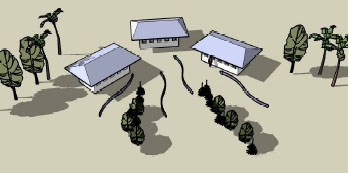Shaping Buildings for the Humid Tropics: Cultures, Climate, and Materials by Patti Stouter, 2008, is a 28 page PDF document that describes how to use ventilation, shading, plantings and insulation to provide comfort in hot humid climates. It includes some discussion of the use of earthbags in achieving these goals.
This is one of the best sources of information about building and living in these challenging regions that I have seen. Patti points out that simple, low-cost buildings can be cool, dry, and mold-free if they are carefully planned. She also discusses the cultural differences that might affect appropriate designs.
She shows how to catch breezes to make the inhabitants feel cooler and to keep the humidity from building up. How to best orient a house to avoid overheating and ways to use landscapping to enhance comfort in buildings is outlined.
“One of the most important goals is to build of ‘lightweight and low heat-storing materials’ so there won’t be much heat radiated towards the inside. Traditional building materials like wood, grass, palm, and bamboo are cheaper as well as cooler than masonry. But because they rot easily or are eaten by insects, they must be used carefully. Natural materials can be used inside to provide sound or heat insulation. Sea grass, rice hulls, and coconut fibers don’t absorb much humidity.”
“Earth buildings last well when maintained, and are less subject to overheating and dampness than stone or concrete. Earth walls don’t get hot or cool very quickly because earth insulates better than concrete. Heavy concrete walls in very humid areas become frequently damp from condensation, causing algae or mold growth. Solid earth walls will receive less condensation than concrete because they are less dense, and because they absorb more humidity.”


Looking for options for American Southeast. Alabama has a hot and humid subtropical climate and we’re trying to see what natural materials we can use that can withstand the humidity and keep the interior comfortable. We get about 60 inches of rain a year.
Earthen materials, like cob, adobe, rammed earth and earthbags, actually handle humidity very well. They can absorb a fair amount of moisture and naturally give it back off. They are also good thermal mass material, so they tend to stabilize interior temperatures. But in most climates, like Alabama, they need to be insulated on the exterior to keep them from getting too hot or too cold.
Wonderful! Could you give me an example of how to insulate the exterior? I did plan on using lime based plasters and white wash to prevent mold/mildew and to allow the natural materials to breath.
It is important for the walls to breath at least on one side, and this can be the interior. I bought an old adobe home several years ago and attached 1 1/2 inches of blue board insulation on the outside with long deck screws with large plastic washers. Then I attached synthetic stucco mesh over the insulation and applied a standard stucco as a protective layer. This has held up well and has made the house very thermally efficient.
I live in the tropic, Boriké, and I’m interested in building my house eco-friendly.
Earthbag is perfect for the tropics.